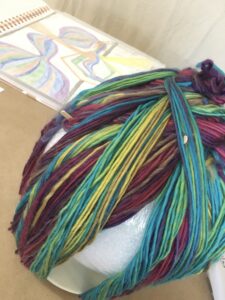Welcome all!
The Merriam-Webster Dictionary defines art in many ways, including as:
- A skill acquired by experience, study, or observation
- An occupation requiring knowledge or skill
- The conscious use of skill and creative imagination especially in the production of aesthetic objects, and the works that are produced in this way.
Throughout the Micromoments in Neuroplexure study, I have been wondering about the art of teaching and the art of researching. Both teaching and research have become heavily scientific, with a focus on statistics, scores, productivity. These are needed, but not to the point of losing the art. The art of teaching and the art of research bring (or keep) the qualities of humanness that cannot be quantified or categorized in the work of teaching and researching.
As humans, we like to say that we are above all other creatures, especially since we have language. We can speak and read and write. But we often forget that we can also think and communicate in ways other than language. And those ways (often called art) are just as human as speaking, reading, and writing. The Neurodiversity Paradigm reminds us that we humans think, learn, communicate, and interact in many different ways. We might learn so much more about our world if we were able to move beyond the ways that we are used to doing things.
During Micromoments in Neuroplexure, collaborators were encouraged to participate using multiple formats to explore micromoments. Most used oral language and a couple used drawing. As I continue working with the contributions to get a better feel for how micromoments move, I am also using multiple formats to think with. I have been sketching microMovements, or movement maps, for several of the microMemories shared during the study. From these sketches, I am building/creating/crafting 3D maps using fiber art, or yarn and threads. The purpose of this art-making is not to create art as a product, but to think through the micromoment and its movement. The process of making is a thinking, an analyzing. The process of making is the research.

Any topic or issue could be researched taking an artist’s approach, which is not usually direct. It is structured and methodological, but it also moves more flexibly with the data, the people, the places, in the study. In the article Art as Research: On the Art of Art Research, multimedia artist John Leaños is quoted as saying, “This transmutation of traditional research and knowledge- that is where the magic is. Artists can engage a problem and have a solution that is hard to grapple with, that is beautiful, that is completely unexpected.”
Arts-based research, called research-creation in Canada, can be used to grapple with complex social issues. In the video Natalie Loveless: Research-Creation and Social Justice, Natalie Loveless introduces research-creation and quickly tells how a group of researchers are working together on issues of disability in the Anthropocene. She states that “research-creation practices can spark intellectual and affective shifts not only to help us understand social injustices but also move us forward to imagine substantial social change.”
It is my hope that the culmination of the work done together in Micromoments in Neuroplexure will do just this, move us forward to imagine substantial social change, especially in inclusive education. Thank you to all collaborators and co-learners that have accompanied me on this journey.
Until next time!
**Post comments are publicly visible.**